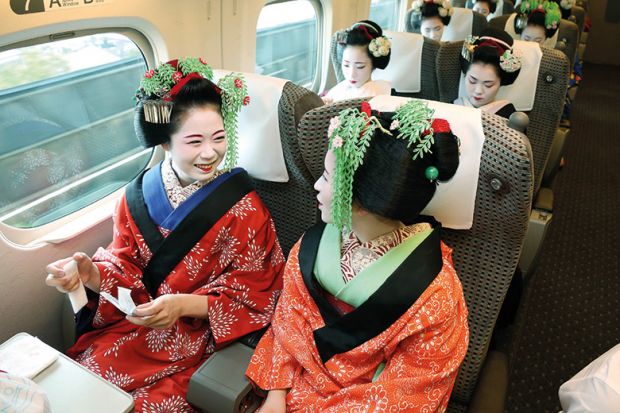There are 100 varieties of lemur in Madagascar, none of which is found anywhere else on earth. The same is true of almost all its reptiles and amphibians, and around half its birds. It has such a unique ecology because it was, for so long, adrift from the rest of the African continent.
This example from the natural world may be an imperfect analogy for Japanese higher education, but it too is a system that has been shaped by isolation.
The result is a unique profile – universities that may share many characteristics with their peers elsewhere, but are also different in important ways. These are coupled with structural, economic and demographic factors in the country at large that all have a direct bearing on universities.
One obvious area in which Japan’s academy differs from other university systems is the level of internationalisation (and while language is one barrier, there are cultural factors at play too).
Another is the expectation of what a university education means. In our cover story this week, which accompanies the inaugural Times Higher Education Japan University Rankings, Akihiko Kimijima, dean of the College of International Relations at Ritsumeikan University in Kyoto, argues that institutions have not taken teaching as “seriously” as they should, since the value of a degree is so highly linked to the reputation of the institution.
Go to the University of Tokyo, and you will get the pick of the most desirable jobs, regardless of what you did while you were there.
According to others we speak to, the culture of Japanese companies (characterised by the fabled “salaryman” who has been institutionalised by his job) is partly to blame, since firms prefer to train new recruits in-house rather than seeking out graduates with the ability to question and challenge – attributes that are considered fundamental to a university education elsewhere.
Our Japan ranking, like the country it assesses, is not an off-the-peg exercise. We do not focus primarily on the research metrics that feature so heavily in our World University Rankings. Instead, we have developed a methodology that builds on our Wall Street Journal/Times Higher Education US College Rankings to directly address the most important aspects of the Japanese context.
With this in mind, we assess institutions’ offer to students by looking at resources, engagement, outcomes and environment.
Within these four pillars, individual performance indicators include the views of student career advisers from 2,400 Japanese schools, of employers (who were asked not about existing reputations but for their detailed experience of graduates they have hired), and of academics, as well as data on such things as the diversity of the student body.
Look beyond campus walls, and the challenges the country is facing are clear enough. A lack of global connectivity – particularly in terms of international talent coming into the country – and a demographic crisis caused by the ageing population are two of the most pressing.
But there is cause for optimism. As is discussed in our cover story, these pressures are forcing the country to reinvent itself in ways that should provide fertile ground for improvement among its universities.
If the demographic crisis means that Japan has to open its borders to more talent from overseas, if funding problems mean they have to work more closely with industry, if Japanese companies demand a workforce that has been stretched and challenged, then this is a crisis with opportunities.
Our rankings can play a part, too. It’s no longer a controversial statement to say that rankings have the power and influence to fundamentally change higher education. There will always be arguments about whether that influence is positive or negative, and at an institution-by-institution level that comes down to how rankings are used by management teams. But on a national scale such as this, they can open a country’s eyes to its weaknesses as well as its strengths, and provide hard data to help light the road to improvement.
By focusing primarily on what Japanese institutions offer students, we believe that these rankings can help to make the next stage of their evolution one that benefits not only those students and graduates, but the country as a whole.
Register to continue
Why register?
- Registration is free and only takes a moment
- Once registered, you can read 3 articles a month
- Sign up for our newsletter
Subscribe
Or subscribe for unlimited access to:
- Unlimited access to news, views, insights & reviews
- Digital editions
- Digital access to THE’s university and college rankings analysis
Already registered or a current subscriber?
